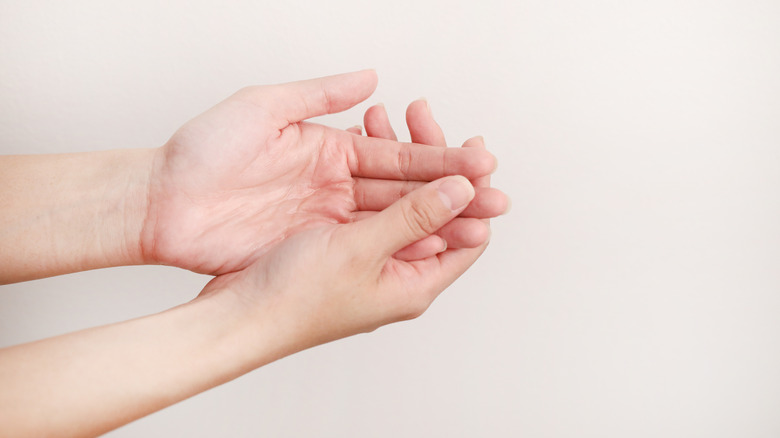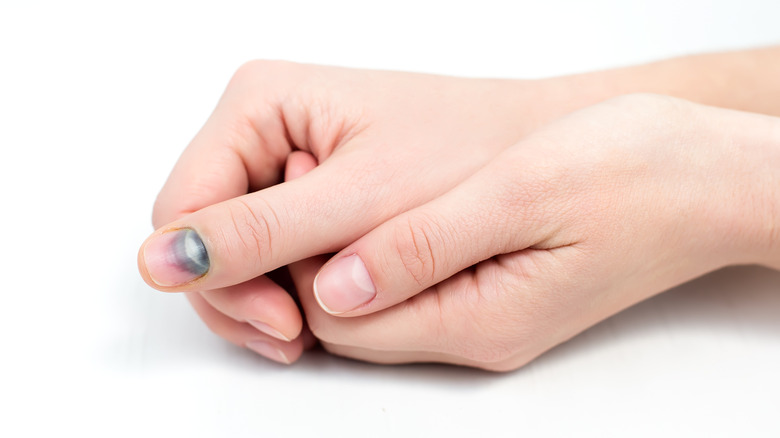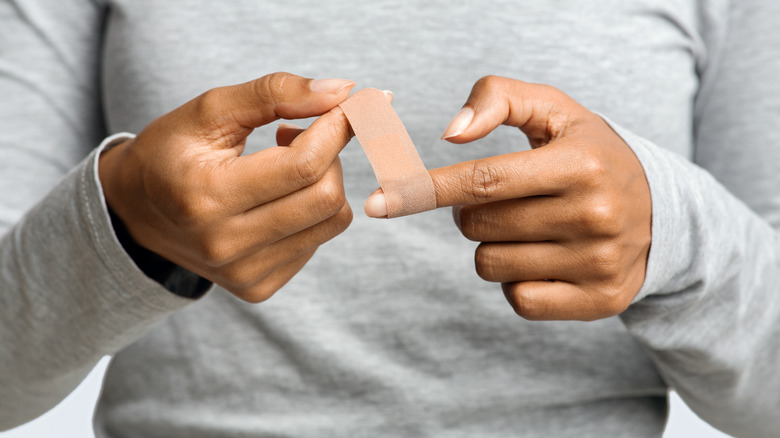Here's What You Should Do When You Bruise A Fingernail
If your nail gets crushed or hit by a strong, heavy object, it may result in a bruise within your nail. Maybe you crushed it between your car door, a window, weights at the gym, or with something during a DIY project, like a hammer. Either way, it isn't a fun ordeal. According to Healthline, injuries of this sort can cause damage to your nail bed when it is crushed, pinched, or cut. This damage can cause a variety of nail bed injuries, such as a nail bed laceration, avulsion, or fractures. It can also cause bruising through what is known as a subungual hematoma.
Many times, it can be treated at home, but proper observation and knowledge about your bruised nail can help you determine if it needs any medical attention beyond that. But don't worry, this common injury isn't as dangerous as it seems, especially with the right care (via GoodRx Health). Knowing what to do when your nail bruises is important for the future health of your nail, your nail growth, and your finger with the injury.
Pain and appearance of a bruised nail
A bruised nail will appear in a mix of red, purple, or black colors, which often signals trapped blood underneath the nail, known as a subungual hematoma. Injuries like this are often caused by blunt force trauma against the nail as a result of damage to the nail bed. The nail bed, however, isn't exactly your nail, but the skin under it. Essentially, the damage is in your skin which is caused by crushing the blood vessels beneath your skin. When it bleeds, it traps blood just between the skin and the nail bed, causing the nail to bruise, per WebMD.
At this point of the bruise, you will feel a tight pressure with throbbing pain. It might also feel sore or tender because the tip of your finger or toe with the bruised nail will also begin to swell. Additionally, you might notice your nail will look discolored, which is a normal part of the process. This kind of damage and bruising can last anywhere from weeks to months, but there are certainly ways you can help boost the healing process at home or with a doctor's visit, per Cleveland Clinic.
How to treat your bruised nail
Oftentimes, a bruised nail doesn't exactly need any further medical treatment other than basic wound care. According to Medical News Today, you can use the R.I.C.E. method at home to treat a mild subungual hematoma: rest, ice, compression, and elevation. Rest by limiting the use of your finger or toe with the bruised nail. Reduce any swelling by using an ice pack or something cold on the nail. This can also help reduce any pain. Next, compression is important to help reduce any blood pooling in the area. This can be done by wrapping the affected area. To even further reduce swelling, keep your hand or foot elevated, which is the last step of the R.I.C.E. method for basic home care. In addition to this care, it is also advised that you take pain medication like acetaminophen or ibuprofen for the sore or throbbing sensation.
Dermatologist Ted Lain, M.D., tells SELF of certain signs that may indicate a necessary doctor's visit, such as loss of blood flow, unusual colors on the skin of your fingertip, or injury to your nail matrix where nail growth occurs. Additionally, a subungual hematoma is considered mild when it covers 25% of your nail, whereas if it covers 50% or more, it needs medical attention, per eMedicineHealth. Many times, doctors can drain the bruise within 48 hours of when the injury occurred to relieve any pressure or pain. If the pain feels too intense, a doctor may be able to determine if you have a fracture or laceration as well.


